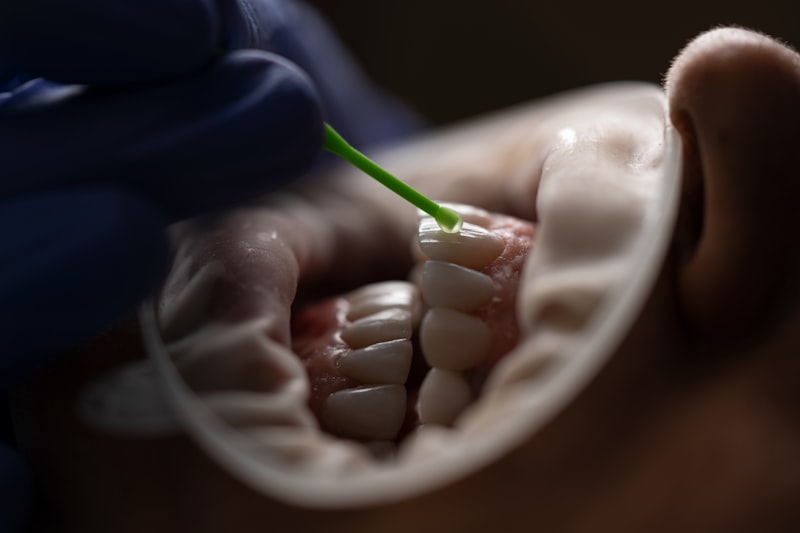Firstly, smoking stains your teeth. The tar and nicotine in cigarettes leave stubborn yellowish stains that brushing alone can’t easily remove. Over time, these stains can become quite noticeable, turning your once-bright smile into a shade you’d rather not show off.
Beyond aesthetics, smoking contributes to gum disease. It irritates the gums, making them more susceptible to infection. This irritation can cause inflammation and even lead to gum recession, where the gums pull away from the teeth. As gum disease progresses, it can destroy the bone that supports your teeth, eventually leading to tooth loss.

Smoking also slows down the healing process in your mouth. Whether you’ve had oral surgery, a tooth extraction, or even a routine dental procedure, smoking can delay healing and increase the risk of complications like dry socket—a painful condition where the blood clot is disrupted, exposing the bone and nerves.

Let’s not forget about bad breath. Smoking leaves a lingering smell that can be hard to mask. It’s not just a matter of brushing your teeth or popping a mint; the odor from smoking penetrates deep into your oral tissues, affecting your breath even when you’re not actively smoking.
In essence, smoking doesn’t just affect your lungs and overall health—it takes a toll on your teeth and gums too. From unsightly stains to serious gum disease, the impact of smoking on your dental health is significant and often irreversible. So, if you’re looking to protect your smile and oral health, kicking the smoking habit could be one of the best decisions you make.
Up in Smoke: The Devastating Impact of Smoking on Dental Health
Let’s dive into the details. Tobacco smoke is a cocktail of harmful chemicals, each one playing a villainous role in this dental drama. Tar, for instance, is like a sticky bandit that coats your teeth, turning them yellow over time. It’s relentless, clinging to enamel and inviting bacteria to join the party.
Then there’s nicotine, the mastermind behind addiction. It constricts blood vessels, reducing the flow of oxygen and vital nutrients to your gums. Picture this: your gums are like the roots of a tree, needing constant nourishment to stay strong and vibrant. With nicotine in the mix, they become deprived, vulnerable to infections and diseases like gingivitis.
Ah, but there’s more. Carbon monoxide, the silent killer in smoke, disrupts the balance of cells in your mouth. It interferes with healing processes, leaving wounds from dental procedures or infections to linger longer than they should. It’s like throwing a wrench into the gears of your body’s natural repair systems.
And let’s not forget the big picture. Smoking isn’t just about the teeth you see; it’s about what lies beneath. The bone structure that supports your teeth can weaken over time, leading to tooth loss. It’s like a foundation crumbling under the weight of neglect.
So, why does this matter? Because your smile is more than just a reflection in the mirror. It’s a window into your overall health. When smoking casts its shadow, it dims that window, hiding potential issues that could affect not only your teeth but your entire well-being.
The impact of smoking on dental health is undeniable. It’s a story of chemicals, addiction, and systemic harm that goes beyond the surface. Understanding this narrative is crucial for anyone looking to safeguard their smile and preserve their overall health.
Yellowed Truth: How Smoking Stains and Discolors Teeth Over Time
Smoking tobacco introduces thousands of chemicals into your body, and some of these chemicals are notorious for causing stains. The main culprits are tar and nicotine. Tar is a sticky substance that easily adheres to tooth enamel, while nicotine, when mixed with oxygen, turns into a yellowish substance that readily seeps into microscopic openings in your teeth.
Think of your teeth as porous like a sponge. When you smoke, these pores absorb the tar and nicotine, gradually causing your teeth to lose their natural brightness. Over time, this buildup becomes more stubborn and harder to remove with just regular brushing.
But it’s not just about the surface stains. Smoking also affects the health of your gums, which can further contribute to the discoloration of your teeth. It reduces blood flow to the gums, making them more susceptible to infection and disease. As the gums recede, more of the tooth’s root becomes exposed, and this area is even more prone to staining.
Unfortunately, the impact of smoking on teeth isn’t just cosmetic. It can also lead to more serious oral health issues such as gum disease and even tooth loss. The combination of tar, nicotine, and reduced blood flow creates an environment where bacteria thrive, leading to inflammation, infection, and eventually, irreversible damage to the gums and bone that support the teeth.
So, what can you do if you’re worried about your smile losing its sparkle due to smoking? Quitting smoking is the most effective way to prevent further discoloration and improve your overall oral health. It’s never too late to kick the habit and start on the path to a brighter, healthier smile.
Beyond Bad Breath: Unveiling the Hidden Dental Dangers of Smoking
Firstly, smoking compromises your immune system, making it harder for your body to fight infections, including those in your mouth. This weakened immunity is particularly concerning for gum disease, as smoking reduces blood flow to the gums, impairing their ability to heal and leading to persistent inflammation.
Moreover, smokers are more likely to develop plaque and tartar buildup on their teeth, accelerating the progression of periodontal disease. This buildup not only damages teeth and gums but also increases the chances of developing oral cancer, particularly in areas where tobacco touches directly.
Beyond the visible effects, smoking can also mask symptoms of gum disease, making it harder to detect and treat in its early stages. This delay in treatment often results in more severe damage to the gums and underlying bone structure, potentially leading to tooth loss.
Additionally, smoking interferes with the production of saliva, which plays a crucial role in neutralizing acids produced by plaque and bacteria in the mouth. Without sufficient saliva, the risk of cavities and decay rises significantly.
Cracking Down: Why Smokers Face Higher Risks of Tooth Decay and Cavities
When smokers inhale, they introduce harmful substances like tar and nicotine into their mouths. These substances not only stain teeth but also contribute to plaque buildup. Plaque, a sticky film of bacteria, thrives on sugars and starches from food. In combination with the acidic components of tobacco, plaque produces acids that attack tooth enamel, causing it to break down and form cavities.
Moreover, smoking reduces blood flow to the gums, compromising their ability to fight infections. This diminished blood flow also hinders the gums’ ability to repair and maintain oral tissues, leading to increased susceptibility to gum disease. Gum disease, in turn, can exacerbate tooth decay as it weakens the supporting structures of the teeth.
The effects of smoking on oral health are profound and often irreversible. Regular dental check-ups become crucial for smokers to monitor their oral health status and address any emerging issues promptly. Dentists may recommend specialized toothpaste and mouth rinses designed to mitigate the effects of smoking on teeth and gums. However, quitting smoking remains the most effective way to reduce the risks of tooth decay and other oral health complications.
Understanding these risks underscores the importance of making informed choices about smoking and its impact on overall health. By taking proactive steps to quit smoking and maintain good oral hygiene practices, individuals can significantly improve their oral health outcomes and overall well-being.
Gum Disease Alert: Smoking’s Role in Accelerating Periodontal Problems
Hey there! Did you know that smoking isn’t just harmful to your lungs but can seriously impact your oral health too? Let’s dive into how smoking accelerates gum disease, also known as periodontal disease.
Picture your gums as the bodyguards of your teeth—they protect and support them. When you smoke, though, it’s like weakening these bodyguards, making them less effective in their job. Smoking reduces blood flow to the gums, which are then deprived of oxygen and essential nutrients. This weakens their ability to fight off infections, like gum disease.
What exactly happens? Well, smoking irritates the gum tissue, causing inflammation. This early stage is called gingivitis and is characterized by red, swollen gums that bleed easily. If left unchecked, gingivitis can progress into periodontitis—a more severe form of gum disease. Here, the gums pull away from the teeth, forming pockets that can harbor bacteria and lead to bone and tooth loss over time.
Imagine smoking as adding fuel to a fire—it makes an already bad situation worse. The chemicals in tobacco weaken the immune system, making it harder for your body to fight off infections in the gums. It’s like leaving the gates wide open for harmful bacteria to wreak havoc in your mouth.
Now, you might wonder, can’t brushing and flossing help? Of course, good oral hygiene is crucial, but smoking significantly increases the risk of gum disease, even if you brush and floss regularly. It’s like trying to protect a sandcastle from waves—it helps, but if the tide (smoking) keeps pounding, the castle (your gums) will eventually erode.
So, if you’re a smoker concerned about your oral health, consider quitting. Your gums will thank you, and you’ll reduce the risk of developing serious periodontal problems down the road.
Frequently Asked Questions
Is there any way to minimize dental damage while smoking
Learn effective strategies to reduce dental damage caused by smoking, including proper oral hygiene practices, regular dental check-ups, and minimizing tobacco use. Discover tips on how to protect your teeth and gums despite smoking habits.
Does smoking increase the risk of gum disease
Smoking significantly increases the risk of gum disease. Tobacco products compromise the immune system’s ability to fight infection in the gums, leading to inflammation, periodontal disease, and tooth loss over time. Quitting smoking can reduce these risks and improve oral health.
Can smoking lead to tooth loss
Smoking can contribute to tooth loss by weakening the immune system, reducing blood flow to the gums, and increasing the risk of gum disease. Over time, these effects can lead to severe gum damage and eventual loss of teeth.
What dental problems are caused by smoking
Learn about the dental problems caused by smoking, including increased risk of gum disease, tooth staining, bad breath, and delayed healing after dental procedures. Smoking can also contribute to oral cancer.
How does smoking stain teeth and can it be reversed
Learn how smoking causes teeth stains and whether these stains can be reversed. Understand the mechanisms through which smoking discolors teeth and explore potential methods to reduce or remove these stains.



